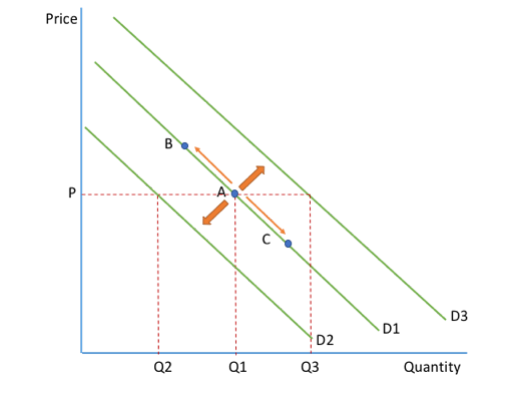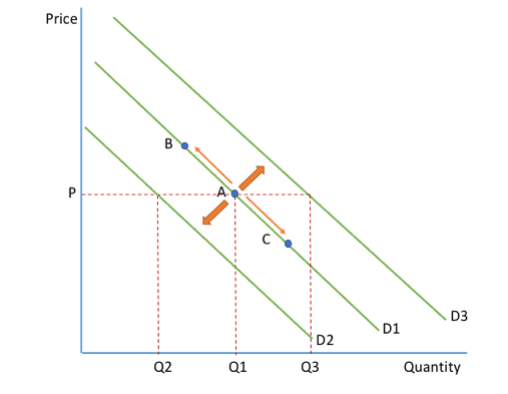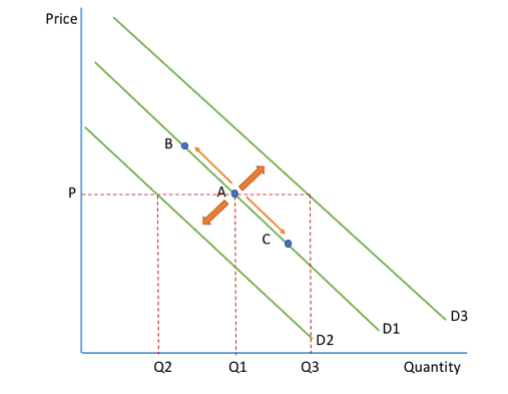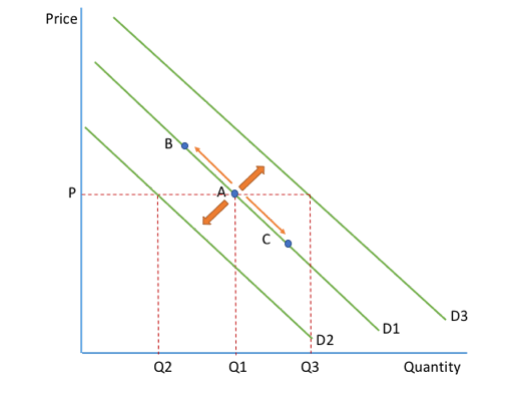1.2.2 Demand
1/18
There's no tags or description
Looks like no tags are added yet.
Name | Mastery | Learn | Test | Matching | Spaced |
|---|
No study sessions yet.
19 Terms
DEMAND
ability and willingness to buy a particular good at a given price and at a given moment in time
MOVEMENT
a movement along the demand curve (A-B) is caused by a change in price of the good

MOVEMENT- C+E
CONTRACTION- movement from A to B in demand- the quantity falls bc of an increase in price
EXTENSION- movement from A to C in demand- the quantity demanded rises due to a decrease in price
movements along the curve not increase or decrease- only happens in shifts

SHIFT
caused by a change in any factors which affect demand, the conditions of demand
shift from D1-D2 is a decrease in demand bc fewer goods are demanded at each and every price ( for eg at price P only Q2 goods are demanded rather than Q1 goods)
shift from D1-D3 is an increase in demand, as more goods are demanded at each and every price (now Q3 goods are demanded at price P)

CONDITIONS OF DEMAND
The conditions of demand are the factors which cause the demand curve to shift
A shift to the right is an increase in demand and a shift to the left is a decrease in demand
PIRATESL

POPULATION
If population rises, demand for all products increase and so the demand curve will shift to the right
bc more people in the country= more people who will want a good
INCOME
if income increases, demand increases bc a person
can afford to buy more of the product
If there is a fall in income then the demand would decrease and shift to the left
but for some goods an increase in income can lead to a fall in demand and vice versa- concept called income elasticity of demand
RELATED GOODS
If goods are complements or substitutes of each other then a change in the price of another good can cause a shift in the demand curve
SUBSTITUTES- buy one good or the other (increase in price of Nike shoes would lead to a contraction in demand for Nike shoes and an increase in demand for adidas shoes)
COMPLEMENTS- one good is bought with another (if price of DVD player decreases, demand for it expands and so for DVDs it increases)
ADVERTISING
If a firm carries out a successful advertising campaign, demand is likely to increase
If a competitor firm carries out a successful advertising campaign, demand for the first firm will fall
TASTE/FASHION
If something becomes more fashionable, we expect demand to increase and if it becomes less fashionable, then demand will fall
EXPECTATIONS
If people expect a shortage of something, or that price will rise in the future, then demand will increase
If people expect that price will fall in the future, demand will decrease
SEASONS
Some products will find their demand affected by the weather
E.G.- hot summers cause an increase in demand for sun cream whilst wet summers cause a decrease in demand for umbrellas
GOV LEGISLATION
Demand for car seats increased after the government made it a legal requirement that young children have to sit in them
LAW OF DIMINISHING MARGINAL UTILITY
The demand curve slopes downward, showing the inverse relationship between price and quantity
can be explained by the law of diminishing marginal utility
SPENDING MONEY
to explain or predict how people will spend their money, we have to assume that they are going to behave rationally, expecting them to spend it according to what gives them the greatest level of satisfaction or welfare
TOTAL UTILITY
represents the satisfaction gained by a customer as a result of their overall consumption of a good
e.g. the satisfaction of eating the whole bar of
chocolate
MARGINAL UTILITY
represents the change in satisfaction resulting from
the consumption of the next unit of a good
e.g. the increased satisfaction by eating another bite of chocolate
LAW OF DIMINISHING MARGINAL UTILITY- STATE
states that the satisfaction derived from the consumption of an additional unit of a good will decrease as more of a
good is consumed, assuming the consumption of all other goods remains constant
DEMAND CURVE
explains why the demand curve slopes downwards: if more of a good is consumed, there is less satisfaction derived from the good
This means that consumers are less willing to pay high prices at high quantities since they are gaining less satisfaction